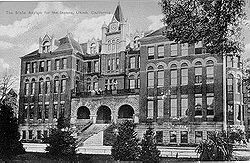Mendocino State Hospital
| Mendocino State Hospital | |
|---|---|
 | |
| Established | 1889 |
| Construction Began | 1891 |
| Opened | 1893 |
| Closed | 1972 |
| Current Status | Preserved |
| Building Style | Cottage Plan |
| Location | Ukiah, CA |
| Peak Patient Population | 3,000 est. in 1957 |
| Alternate Names |
|
History
Mendocino State Hospital, originally the Mendocino State Asylum for the Insane, was established in 1889 (Statutes 1889, Ch. 23). By that law the Governor was authorized to appoint a board of directors of five members for a term of four years to select the site and to manage the institution. In October 1890, contracts were let out for the construction of the male ward building, connecting corridor, kitchen building, laundry, bakery, and the boiler and engine house. The contract for these buildings was for $182,520. On the 26th of January, 1891, contracts were let out for the female building for $89,025,. Three months later, in April 1891, construction began on the hospital. Additional funds were allocated for completion of mentioned buildings, including $60,000 for construction of the administration building.
In 1893, the hospital was renamed as the Mendocino Asylum (Statutes 1893, Ch. 64). With the Insanity Law of 1897, the hospital took on the name of Mendocino State Hospital. The Insanity Law created the State Commission on Lunacy which was given authority to see that all laws relating to care and treatment of patients were carried out and to make recommendations to the Legislature concerning the management of hospitals for the insane. The 1897 law provided that each hospital should be controlled by a board of managers of five members appointed by the Governor for four year terms. On December 12 1893, the Hospital was finished and opened to patients, receiving 60 from Napa State Hospital this same day. Two days later 60 more arrived from Stockton State Hospital and on March 25 30 from Agnews State Hospital, bringing the population to 150.
In 1921, the state hospitals were placed under the authority of the newly-created Dept. of Institutions. The board of managers continued, but only with advisory power. The Dept. of Mental Hygiene was created by an act of the Legislature in 1945 (Statutes 1945, Ch. 665). It was given authority over all state mental institutions. Boards of managers were replaced by boards of trustees with no change in function. Advisory boards were established in 1969 to take over the responsibilities of the trustees.
Following the stock market crash in the late 1920s, patient population increased rapidly. By 1932, the hospital had over 1900 patients and 300 employees. By 1935, the figure had risen to over 2600 patients. Hospital population hit a high in 1955 at over 3,000 patients and 700 employees. Increasing discharges and transfer of the criminally insane to the Atascadero facility eased overcrowding. By 1966, population was back under 1800 patients.
Building construction occurred in spurts over the years. The original main building, completed in 1893, was razed in 1952. With the exception of two wards built in 1910 and 1918, the first major construction project took place between 1925-1933. Little construction was accomplished in the 1940s. Between 1950-55, many new major structures were completed to replace old buildings and to provide facilities for new programs.
Major programs over the years have included treatment for the criminally insane (1929-54), alcoholic and drug abuse rehabilitation, a psychiatric residency program, industrial therapy, and others. As part of a major reorganization by the Reagan administration, the hospital was closed in 1972.
The property was sold and its 488-acre grounds were transformed into the City of 10,000 Buddhas, one of the Western Hemisphere’s largest Buddhist communities. The buildings of the former mental hospital remain. Painted in a soft yellow, the warehouse-like structures have been repurposed. They now serve as a temple and monastery, university, dining hall and dorms, elementary and secondary schools, and a bookstore and gift shop.
Images
Main Image Gallery: Mendocino State Hospital



